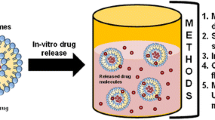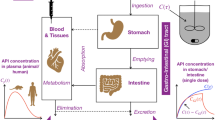Abstract
Nanoparticulate systems have emerged as prevalent drug delivery systems over the past few decades. These delivery systems (such as liposomes, emulsions, nanocrystals, and polymeric nanocarriers) have been extensively used to improve bioavailability, prolong pharmacological effects, achieve targeted drug delivery, as well as reduce side effects. Considering that any unanticipated change in product performance of such systems may result in toxicity and/or change in vivo efficacy, it is essential to develop suitable in vitro dissolution/release testing methods to ensure product quality and performance, and to assist in product development. The present review provides an overview of the current in vitro dissolution/release testing methods such as dialysis, sample and separate, as well as continuous flow methods. Challenges and future directions in the development of standardized and biorelevant in vitro dissolution/release testing methods for novel nanoparticulate systems are discussed.




Similar content being viewed by others
References
Rabinow BE. Nanosuspensions in drug delivery. Nat Rev Drug Discov. 2004;3(9):785–96.
Liu Y, Sun C, Hao Y, Jiang T, Zheng L, Wang S. Mechanism of dissolution enhancement and bioavailability of poorly water soluble celecoxib by preparing stable amorphous nanoparticles. J Pharm Pharm Sci. 2010;13(4):589–606.
Xia D, Cui F, Piao H, Cun D, Jiang Y, Ouyang M, et al. Effect of crystal size on the in vitro dissolution and oral absorption of nitrendipine in rats. Pharm Res. 2010;27(9):1965–76.
Maeda H. The enhanced permeability and retention (EPR) effect in tumor vasculature: the key role of tumor-selective macromolecular drug targeting. Adv Enzyme Regul. 2001;41:189–207.
Greish K. Enhanced permeability and retention of macromolecular drugs in solid tumors: a royal gate for targeted anticancer nanomedicines. J Drug Target. 2007;15(7–8):457–64.
Acharya S, Sahoo SK. PLGA nanoparticles containing various anticancer agents and tumour delivery by EPR effect. Adv Drug Deliv Rev. 2011;63(3):170–83.
Kroll A, Pillukat MH, Hahn D, Schnekenburger J. Current in vitro methods in nanoparticle risk assessment: limitations and challenges. Eur J Pharm Biopharm. 2009;72(2):370–7.
Pumera M. Nanotoxicology: the molecular science point of view. Chem Asian J. 2011;6(2):340–8.
Dokoumetzidis A, Macheras P. A century of dissolution research: from Noyes and Whitney to the biopharmaceutics classification system. Int J Pharm. 2006;321(1–2):1–11.
Dissolution. United State Pharmacopeia (USP). USP 34-NF 29 ed2011. p. 5091–7.
Junemann D, Dressman J. Analytical methods for dissolution testing of nanosized drugs. J Pharm Pharmcol. 2012;64(7):931–43.
Wallace SJ, Li J, Nation RL, Boyd BJ. Drug release from nanomedicines: selection of appropriate encapsulation and release methodology. Drug Deliv Transl Res. 2012;2(4):284–92.
Bhardwaj U, Burgess DJ. A novel USP apparatus 4 based release testing method for dispersed systems. Int J Pharm. 2010;388(1–2):287–94.
Abdel-Mottaleb MM, Neumann D, Lamprecht A. In vitro drug release mechanism from lipid nanocapsules (LNC). Int J Pharm. 2010;390(2):208–13.
Abdel-Mottaleb MM, Lamprecht A. Standardized in vitro drug release test for colloidal drug carriers using modified USP dissolution apparatus I. Drug Dev Ind Pharm. 2011;37(2):178–84.
Kastellorizios M, Burgess DJ. In vitro drug release testing and in vivo/in vitro correlation for long acting implants and injections. In: J. W, Burgess DJ, editors. Long acting injections and implants. New York: CRS; 2012 p. 475–504.
Bhardwaj U, Burgess DJ. Physicochemical properties of extruded and non-extruded liposomes containing the hydrophobic drug dexamethasone. Int J Pharm. 2010;388(1–2):181–9.
Xu X, Khan MA, Burgess DJ. A two-stage reverse dialysis in vitro dissolution testing method for passive targeted liposomes. Int J Pharm. 2012;426(1–2):211–8.
Chidambaram N, Burgess DJ. A novel in vitro release method for submicron sized dispersed systems. AAPS Pharm Sci. 1999;1(3):E11.
Muthu MS, Singh S. Poly (d, l-lactide) nanosuspensions of risperidone for parenteral delivery: formulation and in-vitro evaluation. Curr Drug Deliv. 2009;6(1):62–8.
Avgoustakis K, Beletsi A, Panagi Z, Klepetsanis P, Karydas AG, Ithakissios DS. PLGA-mPEG nanoparticles of cisplatin: in vitro nanoparticle degradation, in vitro drug release and in vivo drug residence in blood properties. J Control Release. 2002;79(1–3):123–35.
Joshi M, Pathak S, Sharma S, Patravale V. Design and in vivo pharmacodynamic evaluation of nanostructured lipid carriers for parenteral delivery of artemether: Nanoject. Int J Pharm. 2008;364(1):119–26.
Chidambaram N, Burgess DJ. Mathematical modeling of surface-active and non-surface-active drug transport in emulsion systems. AAPS Pharm Sci. 2000;2(3):E31.
Chidambaram N, Burgess DJ. Effect of nonionic surfactant on transport of surface-active and non-surface-active model drugs and emulsion stability in triphasic systems. AAPS Pharm Sci. 2000;2(3):E30.
Yoon KA, Burgess DJ. Effect of nonionic surfactant on transport of model drugs in emulsions. Pharm Res. 1996;13(3):433–9.
Bhagav P, Upadhyay H, Chandran S. Brimonidine tartrate-eudragit long-acting nanoparticles: formulation, optimization, in vitro and in vivo evaluation. AAPS PharmSciTech. 2011;12(4):1087–101.
Washington C. Evaluation of non-sink dialysis methods for the measurement of drug release from colloids: effects of drug partition. Int J Pharm. 1989;56(1):71–4.
Levy MY, Benita S. Drug release from submicronized o/w emulsion: a new in vitro kinetic evaluation model. Int J Pharm. 1990;66(1–3):29–37.
Calvo P, Vila-Jato JL, Alonso MJ. Comparative in vitro evaluation of several colloidal systems, nanoparticles, nanocapsules, and nanoemulsions, as ocular drug carriers. J Pharm Sci. 1996;85(5):530–6.
Moreno-Bautista G, Tam KC. Evaluation of dialysis membrane process for quantifying the in vitro drug-release from colloidal drug carriers. Colloids Surf, A Physicochem Eng Asp. 2011;389(1–3):299–308.
D'Souza SS, DeLuca PP. Methods to assess in vitro drug release from injectable polymeric particulate systems. Pharm Res. 2006;23(3):460–74.
Yue PF, Lu XY, Zhang ZZ, Yuan HL, Zhu WF, Zheng Q, et al. The study on the entrapment efficiency and in vitro release of puerarin submicron emulsion. AAPS PharmSciTech. 2009;10(2):376–83.
Juenemann D, Jantratid E, Wagner C, Reppas C, Vertzoni M, Dressman JB. Biorelevant in vitro dissolution testing of products containing micronized or nanosized fenofibrate with a view to predicting plasma profiles. Eur J Pharm Biopharm. 2011;77(2):257–64.
Shono Y, Jantratid E, Kesisoglou F, Reppas C, Dressman JB. Forecasting in vivo oral absorption and food effect of micronized and nanosized aprepitant formulations in humans. Eur J Pharm Biopharm. 2010;76(1):95–104.
Iyer SS, Barr WH, Karnes HT. Profiling in vitro drug release from subcutaneous implants: a review of current status and potential implications on drug product development. Biopharm Drug Dispos. 2006;27(4):157–70.
Zolnik BS, Raton DJ, Burgess DJ. Application of USP apparatus 4 and in situ fiber optic analysis to microsphere release testing. Dissolution Technol. 2005;12:11–4.
Rawat A, Burgess DJ. USP apparatus 4 method for in vitro release testing of protein loaded microspheres. Int J Pharm. 2011;409(1–2):178–84.
Shen J, Burgess DJ. Accelerated in vitro release testing of implantable PLGA microsphere/PVA hydrogel composite coatings. Int J Pharm. 2012;422(1–2):341–8.
Voisine JM, Zolnik BS, Burgess DJ. In situ fiber optic method for long-term in vitro release testing of microspheres. Int J Pharm. 2008;356(1–2):206–11.
Burgess DJ, Crommelin DJ, Hussain AS, Chen ML. Assuring quality and performance of sustained and controlled release parenterals: EUFEPS workshop report. AAPS J. 2004;6(1):100–11.
Martinez M, Rathbone M, Burgess D, Huynh M. In vitro and in vivo considerations associated with parenteral sustained release products: a review based upon information presented and points expressed at the 2007 Controlled Release Society Annual Meeting. J Control Release. 2008;129(2):79–87.
Martinez MN, Rathbone MJ, Burgess D, Huynh M. Breakout session summary from AAPS/CRS joint workshop on critical variables in the in vitro and in vivo performance of parenteral sustained release products. J Control Release. 2010;142(1):2–7.
Siewert M, Dressman J, Brown C, Shah V. FIP/AAPS guidelines for dissolution/in vitro release testing of novel/special dosage forms. Dissolution Technol. 2003;10:6–15.
Heng D, Cutler DJ, Chan HK, Yun J, Raper JA. What is a suitable dissolution method for drug nanoparticles? Pharm Res. 2008;25(7):1696–701.
Tan JP, Goh CH, Tam KC. Comparative drug release studies of two cationic drugs from pH-responsive nanogels. Eur J Pharm Sci. 2007;32(4–5):340–8.
Juenemann D, Bohets H, Ozdemir M, de Maesschalck R, Vanhoutte K, Peeters K, et al. Online monitoring of dissolution tests using dedicated potentiometric sensors in biorelevant media. Eur J Pharm Biopharm. 2011;78(1):158–65.
Peeters K, De Maesschalck R, Bohets H, Vanhoutte K, Nagels L. In situ dissolution testing using potentiometric sensors. Eur J Pharm Sci. 2008;34(4–5):243–9.
Mora L, Chumbimuni-Torres KY, Clawson C, Hernandez L, Zhang L, Wang J. Real-time electrochemical monitoring of drug release from therapeutic nanoparticles. J Control Release. 2009;140(1):69–73.
Michalowski CB, Guterres SS, Dalla CT. Microdialysis for evaluating the entrapment and release of a lipophilic drug from nanoparticles. J Pharm Biomed Anal. 2004;35(5):1093–100.
Hitzman CJ, Elmquist WF, Wiedmann TS. Development of a respirable, sustained release microcarrier for 5-fluorouracil II: In vitro and in vivo optimization of lipid coated nanoparticles. J Pharm Sci. 2006;95(5):1127–43.
Zambito Y, Pedreschi E, Di Colo G. Is dialysis a reliable method for studying drug release from nanoparticulate systems?—A case study. Int J Pharm. 2012;434(1–2):28–34.
Barzegar-Jalali M, Adibkia K, Valizadeh H, Shadbad MR, Nokhodchi A, Omidi Y, et al. Kinetic analysis of drug release from nanoparticles. J Pharm Pharm Sci. 2008;11(1):167–77.
Zeng L, An L, Wu X. Modeling drug–carrier interaction in the drug release from nanocarriers. J Drug Deliv. 2011;2011:370308.
Acknowledgments
The authors would like to thank the US Army Medical Research (#W81XWH-07-1-0688 and #W81XWH-09-1-0711) and the National Institutes of Health Grant (#R43 EB011886-01) for financial support.
Author information
Authors and Affiliations
Corresponding author
Rights and permissions
About this article
Cite this article
Shen, J., Burgess, D.J. In vitro dissolution testing strategies for nanoparticulate drug delivery systems: recent developments and challenges. Drug Deliv. and Transl. Res. 3, 409–415 (2013). https://doi.org/10.1007/s13346-013-0129-z
Published:
Issue Date:
DOI: https://doi.org/10.1007/s13346-013-0129-z




